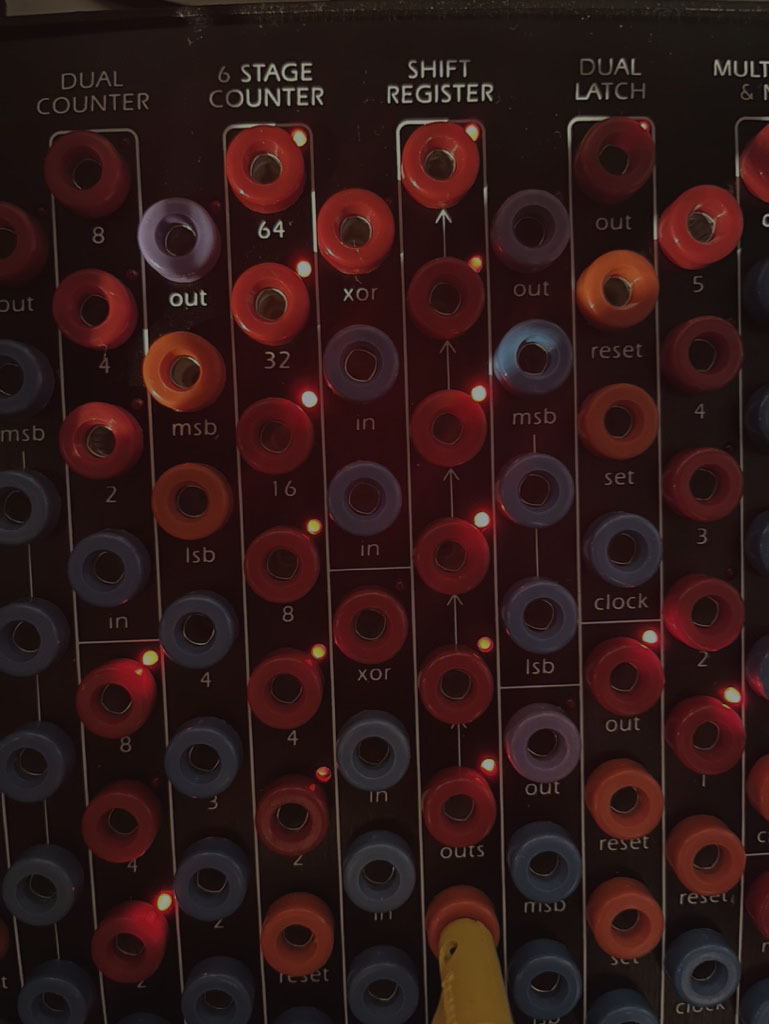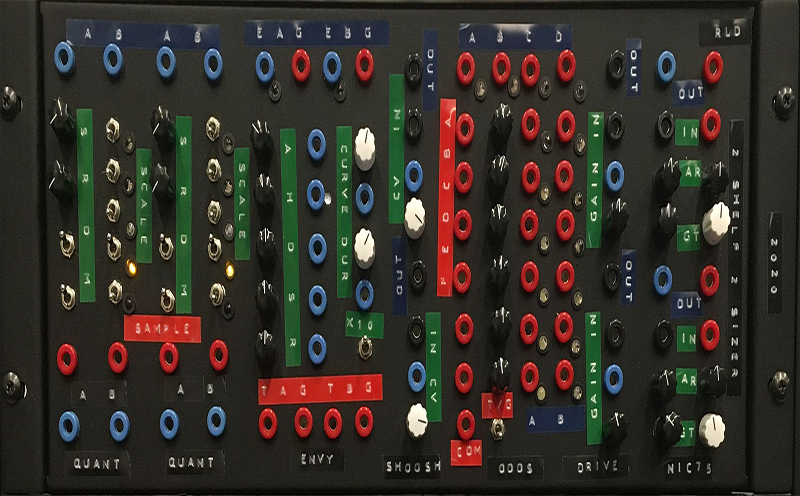
R. Luke DuBois is a composer, artist, and performer who explores the temporal, verbal, and visual structures of cultural and personal ephemera.
DuBois has lived for the last twenty-seven years in New York City.
An active visual and musical collaborator, DuBois is the co-author of Jitter, a software suite for the real-time manipulation of matrix data developed by San Francisco-based software company Cycling’74.
He appears on nearly twenty-five albums both individually and as part of the avant-garde electronic group The Freight Elevator Quartet.
He is the co-director of the program in Integrated Digital Media at the NYU Tandon School of Engineering, and is on the Board of Directors of the ISSUE Project Room and Eyebeam.
His records are available on Caipirinha/Sire, Liquid Sky, C74, and Cantaloupe Music.
His artwork is represented by bitforms gallery in New York City.
What have you been working on lately, and do you have any upcoming releases or performances?
These days I’ve been working on a new curriculum for an undergraduate course called Analog Heaven; restoring an ARP Avatar with some students; building guitar effects pedals + I’m also hoping to do some performances soon.
Earlier in the summer I played a show at Harvestworks on Governor’s Island in New York using a THC 73-75 Homebuilt system and nothing else, it was so much fun.
I would love to do more shows.
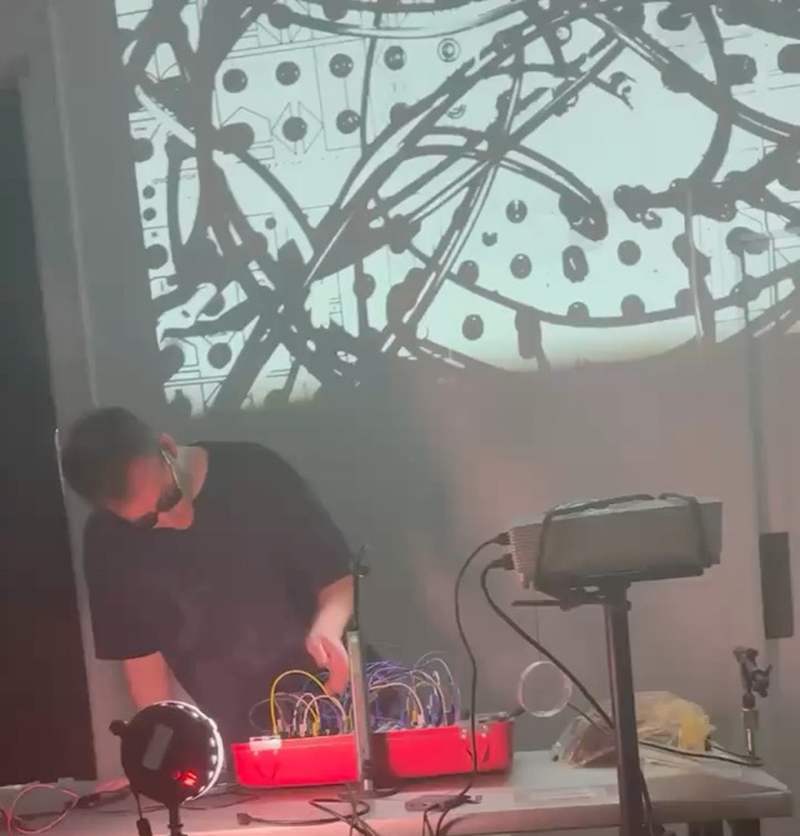
How were you first acquainted to Modular Synthesis? When did that happen and what did you think of it at the time?
I went to Columbia University, and during my first year there (1993) I started working at the Electronic Music Center. At the time it was still very much an analog place, and most of the equipment dated from the 1960s and 1970s – test oscillators and reel-to-reel tape and EMT plate reverbs. They had one of the first Buchla 100 Series systems, as well as two Serge modular systems from the 1970s. A lot of the equipment was built in house – early experimental tape delays, mixing boards with really unusual routing capabilities, Buchla-format modules that they made themselves, and so forth.
I fell in love pretty quickly with the modular systems, and by 1995 I was composing music where I would sample the Serge and then process the sounds digitally using the CMIX language on the NeXT. With the Freight Elevator Quartet (starting in 1996), my professors would let me take out one of the three-panel Serge systems or a small 2×6 Buchla system for shows, so over time the modular systems became more of an instrument for improvisation and performance than a studio tool.
As I started working more and more on digital systems I would still rely on modular synthesizers for inspiration whenever I wanted to make something really direct and tactile.
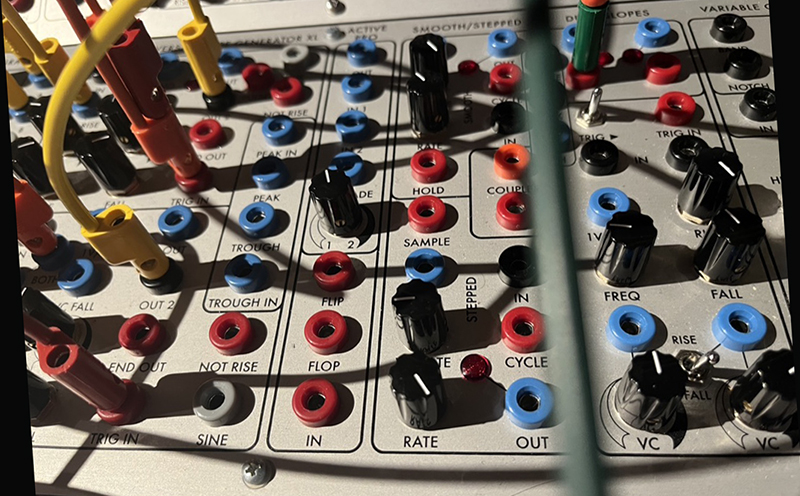
When did you buy your first system?
For the first ten years that I was using modular synthesizers, I was fortunate to have access to university equipment. This coincided with a period in music technology where modular synthesizers were somewhat out of vogue. Today, musicians tend to know that analog synthesizers exist and can recognize them, but in the 90s I would play shows where no one had ever seen one of these things before.
After Columbia I spent the next fifteen years working with video, and intermedia, and computers, and would return to the modular systems from time to time for special performances. So the first system I “bought” was when we decided to establish the audio lab at NYU Tandon in 2018. We commissioned a four-panel Random*Source Serge system built by Darrin Weiner at Patch Point in Berlin as our first piece of equipment, and we’ve been expanding on the system ever since.
What was your first module or system?
The studio I worked in at Columbia had a San Francisco Tape Music Center-era Buchla 100 Series (complete with a “red panel” 158 dual oscillator), as well as a three-panel mid-1970s Serge (two panels of modules and a TKB). One thing I remember really clearly was that we “weren’t supposed to use them yet” – in other words, the professor of the course I was taking really wanted us to only focus on working with test oscillators and tape, and then adding in envelope generators and filters and so on much later. So I was kind of skipping ahead. The Buchla had no manual – only a sales brochure – but there was a printed copy of Rich Gold’s Serge book in the room.
Years later, after I learned a lot more about Serge Tcherepnin and his designs, I realized that the Columbia system was probably the most conservative Serge panel layout possible. Vladimir Ussachevsky – who presumably selected the modules – was really interested in them, but in fairly traditional terms; so the Serge systems he bought had no wave multipliers, waveshaper, resonant EQ, smooth/stepped generator, or anything like that. It was mostly oscillators, envelope generators, filters, and VCAs – a pretty “East Coast” selection for a “West Coast” synthesizer. Despite that, it changed my life.
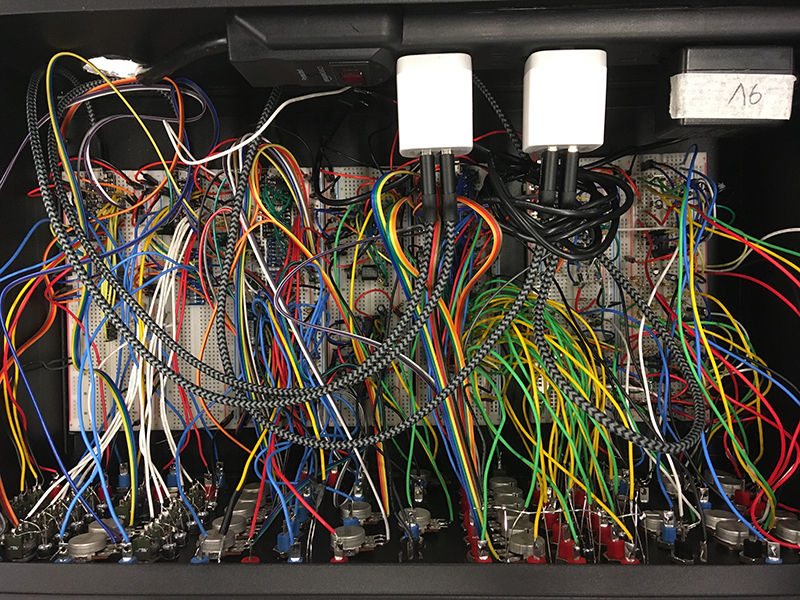
How long did it take for you to become accustomed to patching your own synthesizer together out of its component parts?
I was definitely guessing at first, but I guess the upside is that I had never really worked with an analog synthesizer that wasn’t modular, so I assumed it was pretty normal to have to connect everything yourself to get anything working.
At the same time I was starting to work with the Serge and Buchla systems I was learning how to program a DX-7, use MIDI sequencers, and work with computer music languages on the NeXT, so in my 18 year-old mind I had these things in separate categories. Since I’d never used a synthesizer like a Moog or ARP I sort of assumed that “analog” meant “improvise everything and edit it later”, and “digital” meant “plan everything out precisely ahead of time”. When I started working more extensively with Max in the late 1990s a lot of my compositional process focused on strategies to get expressiveness and organic processes out of the computer, but I was never one of those folks who wanted to get a modular to perfectly sequence a melody in a reliable fashion. They were very different technologies to me.
What was the effect of that discovery on your compositional process?
On your existence?
One of the things that I love about Serge systems is the nomenclature is from the perspective of the circuit rather than the obvious musical use of the circuit. As a result, it takes a little while before you figure out that a “slope generator” can be used for envelopes; then one day you discover it can trigger itself and be used as an oscillator; then one day you discover you can run an input through it and it can be this amazing filter / envelope follower / slew machine. This path of discovery continues endlessly.
I grew up as the one musician in a non-musical family, so I was constantly making music by myself – playing guitar and bass and using a 4-track tape recorder. Once I saw the modular systems – and discovered that the secret weapon of these systems is their ability to sequence and automate in dialog with direct, tactile, human performance – it was revelatory for how I approach music. Learning that “composition” and “improvisation” aren’t opposites, but parameters in a complex, high dimensional space of musicianship, was really liberating, especially for someone who was still studying music in an academic environment where dodecaphonic techniques and other modernist systems-based approaches were still being taught as the “proper” way to compose.
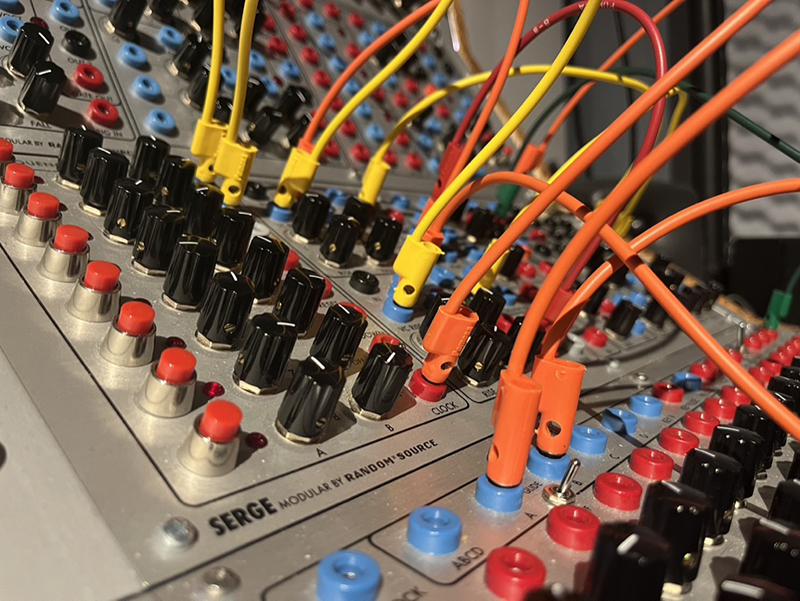
Quite often modularists are in need for more, their hunger for new modules is never satisfied? How do you explain that?
It’s interesting that modular synth artists are stereotyped as having some pathological behavior around acquiring more gear / spending all their money. The people behind that myth clearly have never met an electric guitarist with seven different overdrive pedals.
Seriously, though, I think one thing about modular systems is that it’s easy to see each new module as an entire new world of possibility, and I think in certain circumstances that may be true, but it’s important to remember that constraints are, quite often, creatively productive. The last live shows I’ve done, as I mentioned, have been with a two-panel paperface system, and the limits that set of modules put on what I can do is far more creatively empowering than having a million possible circuits at my fingertips.
I spent a few weeks one summer in Nashville, Tennessee as a Pro Tools editor on a gospel recording. One of the local engineers I befriended was a guitar player, and he had a studio in the basement of his house that was full of gear. Not equipment, but gear. This was in the late 1990s, so computers aren’t fast enough yet for the DAW to do everything and the analog resurgence has yet to begin. As a result, everything is outboard and digital – 19” racks everywhere, etc. So my friend had all this rack gear, plus more pedals than I’d ever seen in my life and a whole wall full of guitars. I went to see him perform half expecting to see a moving van outside the club with everything in it. Instead, he was on stage with a stock Telecaster and a single pedal – a clean boost to give him extra gain on the solos so the backline amp at the club would start to sing, and it was magic. Limitations can have value.
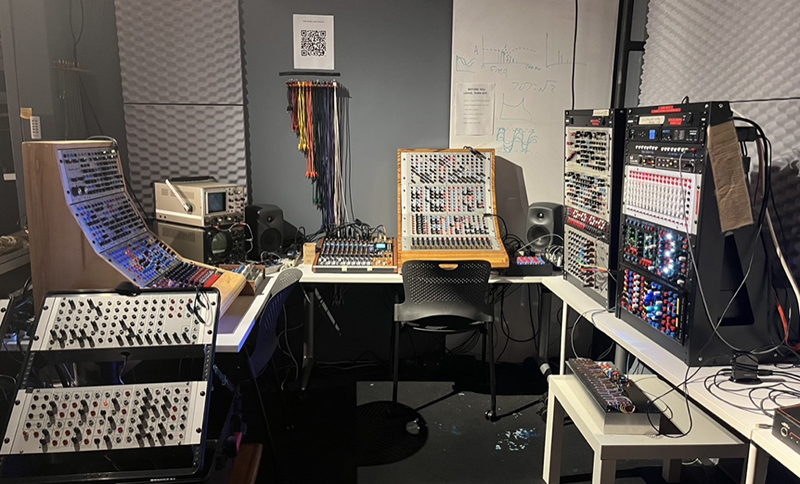
Instrument building may actually be quite compositional, defining your sonic palette, each new module enriching your vocabulary. Would you say that their choice and the way you build your systems can be an integral part of your compositional process? You appear to favor Serge system, why?
All musicians develop an intimate relationship with their instrument over time, and get to understand what’s possible, what’s hard, what’s idiomatic, what’s idiosyncratic… Those things are all part of musicianship whether you play an analog synthesizer or a kazoo. String players understand how different woods and binding techniques impact instrument feel, tone, sustain, etc.; modular performers will learn how different sets of modules interoperate. One of the quirks of the Buchla systems at Columbia was that they had an unusually high oscillator count – the 100 Series in the main studio had something like 6 or 7 different dual oscillator modules, so when I first started learning synthesis I would do these extravagant, paraphonic contrapuntal studies where there were like twelve voices going on. Once I got out of the studio and started performing live with a three-panel Serge, there were only two dedicated oscillators – though with Serge systems nearly anything can be an oscillator – so I adapted how I worked with everything.
I love Serge systems because there are no “wrong answers” with the way in which the modules are connected and the designs don’t push you down a specific path of action. I also love their aesthetic – the iconography and nomenclature make you feel like you’re using something really unique. I also admire their ergonomics – 4U feels like a comfortable size to me, and banana cabling allows for more expressive, in-the-moment patching than 3.5mm cables.
As an educator, these same factors apply for why I think Serge systems are amazing to teach with.
How is your system evolving when Serge isn’t really making new modules any longer?
I suspect Serge Tcherepnin still has a few tricks up his sleeve, like the GTO design of his that was just released by Random*Source. But there’s also more to his inventions than the specific set of module designs he made in the 1970s – the form factor, the cabling and voltage standards, the user interface conventions, and the conceptual framework of a Serge – patch programmability; letting the function of the circuit express itself in a clear way; the refusal to make a CV/audio distinction; and so forth. So at NYU we make Serge-inspired modules every year which we call “Shelfisizers” – they’re 4U and use banana jack interfaces, but half of them are hybrid digital circuits that use Arduino microcontrollers. They’re not official Serge modules, and they’re not necessarily “analog” in the pedantic sense of the term, but they’re certainly inspired by him and his thinking as an instrument-builder.
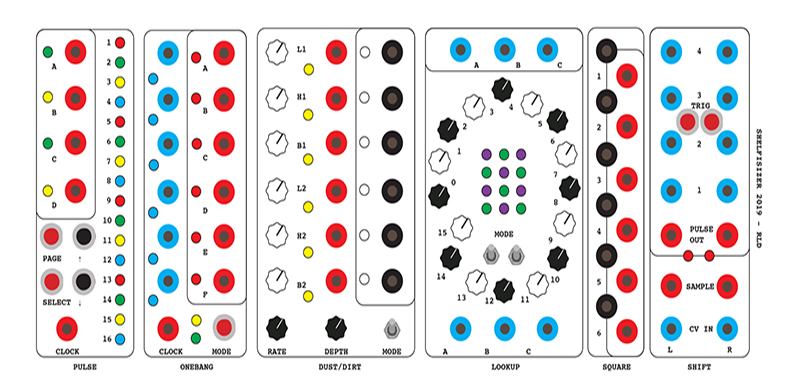
Could you please tell us more about that Shelfisizer? When did you originate it? How did that occur? Story, details of creation, detail every module and develop anything of importance please…
The Shelfisizer Project started out in 2019 as an attempt to get my students at NYU invested in interfacing their own electronics ideas with the Serge system. Most of them – at the time we started, probably all of them – were far more comfortable with designing using microcontrollers, low-current digital outputs for driving LEDs, etc. than full-on analog synthesis modules; if they knew analog electronics at all it was in the context of sensors going into the ADCs on these digital chips, so they could e.g. wire up potentiometers to change variables in their code.
We started out by brainstorming things that would be interesting to do with a digital microcontroller that would integrate nicely with an analog system. I had the students do a bunch of design research on the ways in which microprocessors – not DSPs, but really microprocessors – were integrated into analog synths, so everything from early sequencers like the Oberheim DS-2 to the Zilog Z-80 chips in the Sequential synths that allowed for present management to the hybrid Buchla systems. We settled on an ATmega328-based microcontroller that Adafruit makes called the Metro Mini and prototyped our modules around it.
The first module we designed was a simple 4-channel step sequencer where the constraint was to fit it into a hypothetical 2-inch Serge module. We called it “Pulse”, and it has this maddening UI where the whole thing is navigated with four buttons with only LEDs for feedback, just like you would have on a 1970s sequencer. It has non-volatile memory but only one memory slot, so you can save one paltry 64-value array.
From there we designed some other modules – “Onebang” is based on one of my favorite Max/MSP objects – the clock input samples six unipolar voltage inputs and outputs up to six pulses based on a bunch of thresholds and comparisons – great for generating rhythms from LFOs and similar in feel to shift-register / low-bit ADC things like the CGS Gated Comparator or the resistor ladders on the Meta. “Dust / Dirt” are a bunch of textbook digital noise generators – you can have it constantly generate noise or put out a burst with a trigger input. “Lookup” is a sixteen-stage sequencer that can be indexed by CV rather than clocked, so a 0V input will output the first stage and a 5V input will output the last stage. The last two modules on that panel are analog things the students were interested in – “Square” is a simple analog op-amp comparator module and “Shift” is an ASR like the Serge one but with four stages instead of three and terrible signal droop on the outputs because we did something wrong in the design; we decided to leave it as a feature, as there’s something really haunting about having a beautiful interlocking canon of CV and then you switch off the clock and everything starts to slowly dive bomb out of tune.
The second panel was made with a different batch of students the following year in the depths of the pandemic, so all the students in the course tried to build things at home. It’s a 1U, 3-row, 16-state trigger / gate sequencer that can be used for generating rhythms and whatnot – it has 48 output jacks so it’s a handful. It has tri-color LEDs and you can have a bunch of different ways for moving through the sequences. We called in the “Shelfisequencer” and was the opposite of the “Pulse” module the year before – the entire pattern you’re working with has to be exposed by the patch cables.
The third panel – anachronistically called the “2020 Panel” because we started to design it before the shutdown but didn’t actually build it until 2021, had a bunch of interesting ideas in it.

Its first two modules are a pair of CV quantizers (“Quant”) similar to Craig Lee’s design but with more scales, a transposition function, and an ill-conceived portamento parameter that pretty much nixes the quantization effect if you turn it up more than around 10%; for this we used the Metro Mini augmented with 12-bit DACs for better resolution.
The “Envy” module is a long-form (up to an hour) dual AHDSR inspired by a conversation with Todd Barton about the Buchla MARF. It has a x1 / x10 / x100 3-way switch that’s super satisfying to use. The other digital module in the panel is called “Odds”, and it does six channels of Bernoulli Gating. I think of all the digital modules in the Shelfisizer this one – along with the “Onebang” from 2019 – is the one I use all the time in my own work.
The other three modules are analog – students implemented a dual vactrol-based VCA design called a “Shoosh”, a canonical MXR-style diode distortion called “Drive”, and Nic Collins 1975 Electronotes envelope follower, which I think is super interesting to bring into the Serge universe because it has some design similarities to a DUSG in that it’s patch-programmable to do AR envelopes and monostable delays as well.
The current Shelfisizer project (in progress) is a capacitive touch sensing keyboard that can do “amazing things with arpeggios”. Right now the most amazing thing about it is all the ribbon wire we threaded through a hole in the panel plate, but I have high expectations.
As I said earlier, it’s easy to undervalue the format or, for want of a better word, platform that Tcherepnin invented and simply focus on the specific circuits. The Serge schema for module layout, voltage types, is extremely elegant and can easily accommodate digitally controlled circuits; many Arduino-compatible chips use 5V logic and can work right with existing Serge modules in a way that’s much more challenging with Eurorack synthesizers.
Speaking of extending do you think that Bugbrand, Modcan, Ciat-Lonbarde, or Kilpatrick Audio may manage to bring the Serge spirit further?
I think it’s terrific that there are multiple systems that use banana jacks and the 4U format and can interoperate with Serge equipment. I’ve looked at designs by Logan Erickson (Low-Gain Electronics), Peter Blasser (Ciat-Lonbarde), and Jon Nensén (THC), and I think they’re all stellar. I also think Charlie Kerr’s Loudest Warning format is an excellent move forward – allowing folks to build up panels in a more à la carte fashion is a good thing. Finally, I think it’s terrific that Serge’s early paperface modules have had such a resurgence.
I started working with Serge equipment almost 30 years ago, and I knew the instruments were already 20 years old; it’s amazing that there’s still an incredible community of practice around these instruments 50 years on, and so I definitely hope that this growth continues.
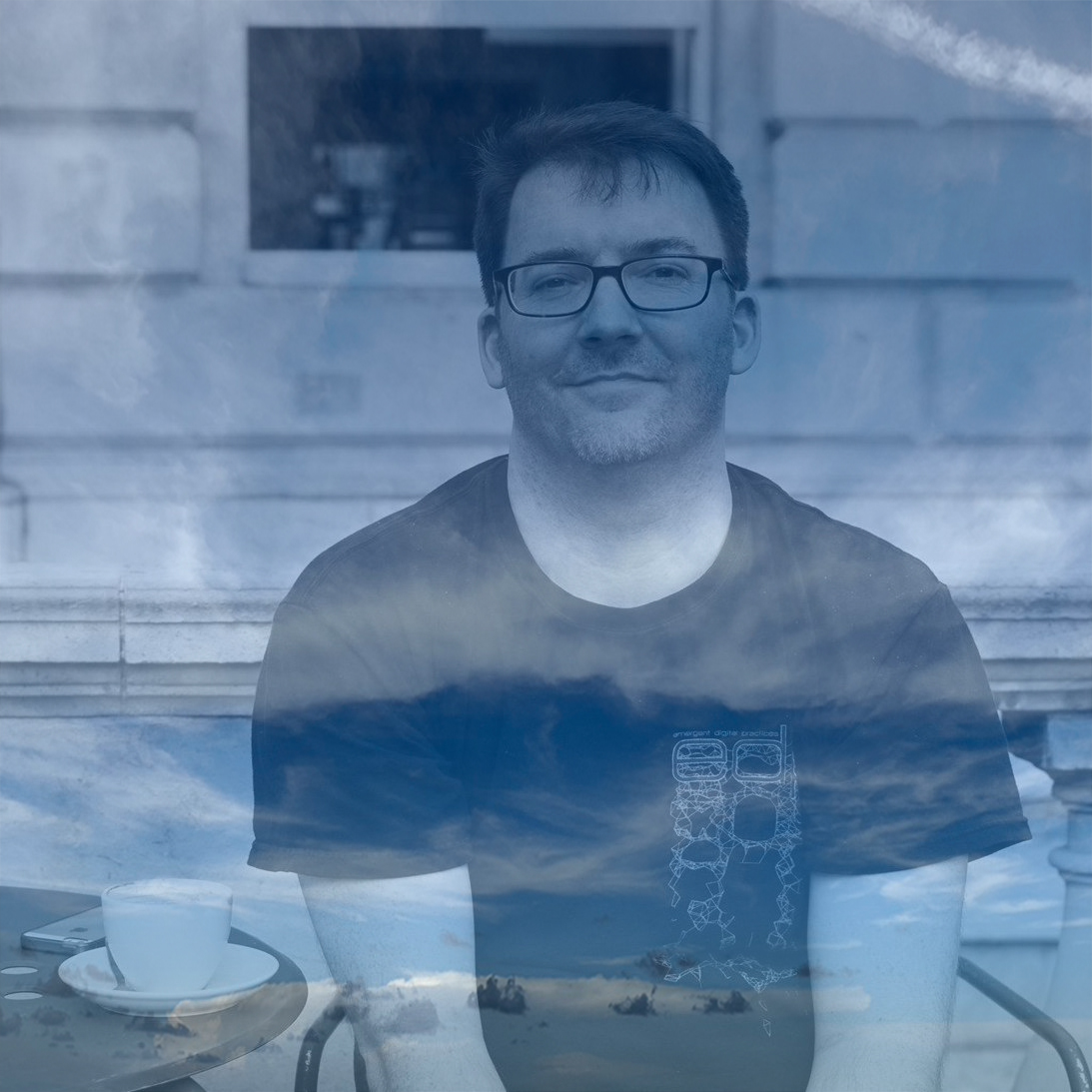
Do you tend to use pure modular systems, or do you bring in outside effect and devices when playing or recording?
When I perform live I try to keep things simple, less for aesthetic reasons and more because I hate carrying around all the gear. In the studio I’ll use different things – we have a DIY plate reverb made with an IKEA shelving unit and guitar pickups that I really love, and I have a bunch of effect pedals lying around that are fun to use from time to time – classic BBD chorus and echo pedals like the Electro-Harmonix Memory Man sound particularly good with a Serge.
One thing I’ve added to my setup since the pandemic is a very nice top-down document camera, which I attach to a video projector, so that I can project what I’m patching behind me.
Would you please describe the system you used to create the music for us?
Can you outline how you patched and performed your Modulisme session?
Everything you hear in these tracks was excerpted from single live takes with no interstitial editing. Most of the takes are quite long so I jumped to spots where the waveform looked interesting, cut out a section, and faded it in and out for us to enjoy. There’s a set of takes from January / February and another set from this past July.
I did everything using the Serge equipment we have in our studio – we have six panels of Random*Source modules (mostly Serge, but also a Jürgen Haible phaser and flanger), an STS Red Control and two CGS panels – a “Black Swamp” that I bought used but was purportedly built by Charlie Kerr and a brilliant sixteen-stage Programmer panel. I also used the Shelfizer panels I’ve made with students over the past few years. Finally, I built a THC Meta box this summer which makes its appearance around mid-July.
There’s very little post-processing though I did take the liberty of putting the mix through a mastering compressor to make the signal a bit more even. The reverberation you hear is a microphone inside the piano in the studio picking up the dry synthesizer signal out of the monitor speakers; we had an ill-conceived plan last year to make the piano into a sympathetic string resonator by putting small speakers inside of it and holding down the sustain pedal with a brick. This didn’t work at all, but it makes for a nice warm small room sound.
I always start – as per my brilliant friend Todd Barton – with a beginner’s mind – so at the beginning of the set I have nothing patched, and then I build up layers. Often it goes one of two ways – I start with something fairly predictable and rhythmic and make it degrade in an interesting manner, or I’ll start with something highly chaotic and try to make it do something musically sensible. Both directions have this sweet spot in the middle where I’m really struggling to remember what the hell is going on – those are generally the sections I’ve excerpted for you.
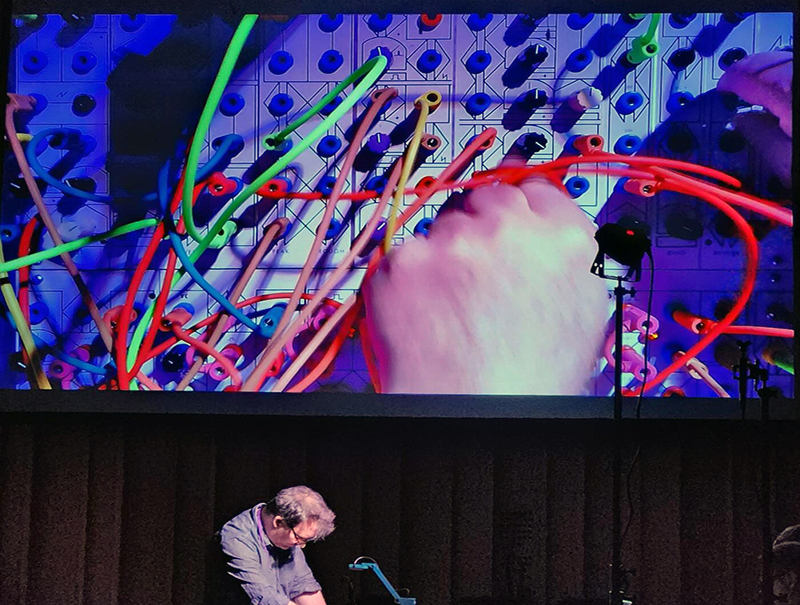
What do you think that can only be achieved by modular synthesis that other forms of electronic music cannot or makes harder to do?
There is a beautiful irony to the fact that modern society’s overall understanding of electricity and electronics focuses on reliability and stability, yet the reason these machines are so compelling to many of us is because it’s a folly to try and do the exact same thing twice. With modular synthesis, if you take an open-minded approach, anything can happen – except of course, the precise thing you thought you wanted to happen.
What would be the system you are dreaming of?
I have my dream system already, but I would love to see more people designing new Serge-format modules – especially ones that focused more on audio processing. I can easily imagine new variations on CV-controlled equalizers, distortions, modulation effects, etc.
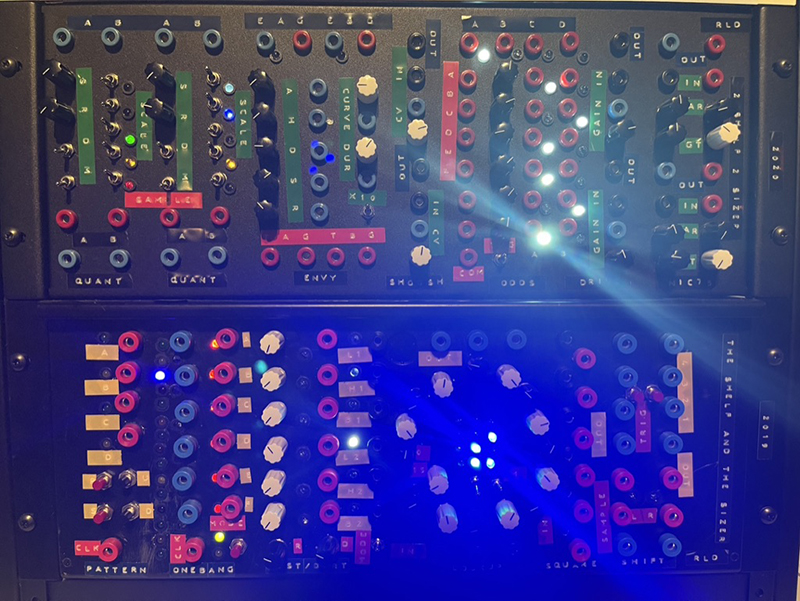
Are you feeling close to some other contemporary Modularists?
Which ones?
I loved the Dani Dobkin and Michael Schumacher sets from earlier this year. They’re both absolutely brilliant composers and two of my favorite people.
Which pioneers in Modularism influenced you and why?
I think Todd Barton is one of the most generous and innovative musical thinkers I’ve ever met.
I was also a co-worker of the late Darwin Grosse, who in addition to being an incredibly kind, lovely person, made beautiful music integrating analog and digital techniques.
And over the years, I’ve spent quite a bit of time with Mort Subotnick, who has always given me a lot of inspiration.
Any advice you could share for those willing to start or develop their “Modulisme” ?
I tell my students that working with modular synthesizers involves embracing a mentality that melds together instrument design, musicianship, composition, and improvisation. Your hand-eye coordination is less important than your strategy in deploying your body effectively; the engineering premise behind individual modules is less important than the way they interact with one another; your best plans for what you’re going to make today are far less important than the journey you’ll take to get there; the whole is greater than the sum of its parts.

